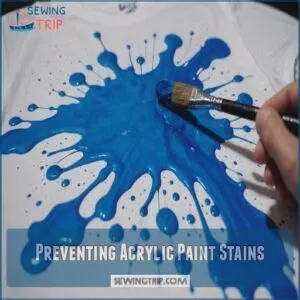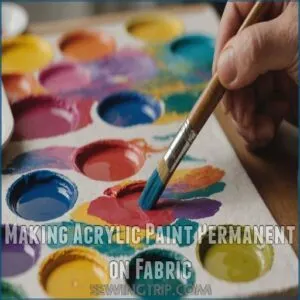This site is supported by our readers. We may earn a commission, at no cost to you, if you purchase through links.

For fresh stains, run cold water through the back of the fabric immediately to flush out the paint.
Then, pre-treat with liquid detergent and wash in the hottest water safe for the fabric.
Dried acrylic is trickier but not impossible – you’ll need isopropyl alcohol or specialized products to break down the paint.
While your favorite shirt isn’t necessarily doomed by an acrylic accident, timing is important.
The longer you wait, the harder it becomes to remove those stubborn paint splatters completely.
Table Of Contents
Key Takeaways
- You’ll need to act fast with fresh acrylic paint stains – immediately run cold water through the back of the fabric and pre-treat with liquid detergent before washing.
- If you’re dealing with dried acrylic paint, you can still remove it using isopropyl alcohol and gentle scraping, though it’ll require more effort and patience.
- You shouldn’t use harsh chemicals like ammonia, acetone, vinegar, or window cleaner as they can damage your clothes without effectively removing the paint.
- You can make acrylic paint permanent on fabric if you want to by mixing it with fabric medium in a 1:1 ratio, but once it’s set, it won’t wash out through normal laundering.
Removing Fresh Acrylic Paint
Fresh acrylic paint is much easier to deal with if you act quickly, as waiting can lead to a rubbery texture that’s difficult to fix, learn more about how to fix rubbery acrylic paint.
Start by rinsing the spill with cold water through the fabric’s back and catching any leftover blobs with a spoon before pre-treating the stain with detergent.
Flushing Paint From Clothing
When acrylic paint lands on clothes, quick action’s key! Grab that clothing item and head over to your sink. Here’s your game plan:
- Rinse with Cold Water: Let it flow through the back of the fabric.
- Identify Fabric Type: Delicate fabrics need extra care.
- Consider Stain Size: Bigger stains need more rinsing.
- Note Paint Thickness: Thicker paint requires longer flushing.
Pre-treating Stains With Detergent
Next up, it’s time to roll up your sleeves and tackle those acrylic paint stains with the right laundry detergent.
Grab a good stain remover or liquid laundry detergent—brands like Tide or Persil work wonders—to pre-treat the garment.
Gently rub the detergent into the stain, letting it soak for a bit.
This will help prevent the stain from setting in!
Laundering Clothes Normally
After pre-treating, toss your garment into the washing machine.
Choose the hottest water setting your fabric can handle; check the care label!
Use your regular laundry detergent—powder or liquid works.
For stubborn stains, add a stain remover.
Once the wash cycle finishes, check the stain before putting it in the dryer.
High heat sets stains, so air-drying is safest.
Removing Dried Acrylic Paint
Dealing with dried acrylic paint on clothes might feel like facing a stubborn stain war.
But don’t worry—scraping with a knife and using isopropyl alcohol can help you win this battle effectively.
Scraping Off Paint With a Knife
Spotting dried acrylic paint on clothes can feel like finding gum under a table—annoying and sticky.
Grab a butter knife or a specialized fabric paint scraper tool, and gently scrape the paint.
Choose a straight, steady scrape direction to avoid fabric damage.
Thicker paint layers might need extra patience.
Remember, the goal is gentle persistence, not tearing your clothes.
Applying Isopropyl Alcohol
Once you’ve scraped off the excess paint, it’s time to tackle the stain with isopropyl alcohol.
Grab a clean cloth and dampen it with the alcohol.
Gently dab the stained area, working from the outside in.
The alcohol breaks down the acrylic paint, making it easier to remove.
Be patient and persistent – you might need to repeat this process a few times for stubborn stains.
Flushing Alcohol From Clothing
So, you’ve tackled the acrylic paint stain with isopropyl alcohol.
Now, it’s time for flushing alcohol properly from the fabric.
Run cold water through the back of the stain to prevent fabric damage.
This step is essential in alcohol removal, preventing fires and ensuring the paint doesn’t sneak back like an unwanted guest.
Keep an eye on that clothes stain!
Effective Stain Removal Methods
You’ve got more tools in your stain-fighting arsenal than you might think.
From common household items like baking soda and dish soap to surprising solutions like hairspray, there are several effective methods to tackle those stubborn acrylic paint stains on your clothes.
Using Baking Soda and Dish Soap
Baking soda and dish soap are your secret weapons against stubborn acrylic paint stains.
This dynamic duo works wonders on both wet and dry paint.
Here’s how to whip up this DIY stain remover:
- Mix equal parts baking soda and dish soap
- Ad
Applying Hairspray With Caution
Hairspray can be a handy tool for tackling acrylic paint stains, but you’ll need to tread carefully.
Not all hairsprays are created equal, and some might do more harm than good.
Here’s a quick guide to using hairspray on your paint-stained clothes:
| Spray Type | Drying Time | Test Fabric | Stain Removal |
|---|---|---|---|
| Alcohol-based | 1-2 minutes | Always | Good for fresh stains |
| Non-alcohol | 3-5 minutes | Recommended | Less effective |
Remember, hairspray isn’t a miracle solution.
It’s best for fresh stains and mightn’t work on all fabrics.
Avoiding Harsh Chemicals
While hairspray can be a quick fix, it’s best to steer clear of harsh chemicals when tackling acrylic paint stains, especially when working with delicate fabrics that may require gentle cleaning with mild soap techniques.
You don’t want to trade one problem for another by damaging your favorite shirt!
Stick to gentler, eco-friendly options like dish soap or baking soda mixtures.
These natural stain removers are gentler to your clothes and the environment.
Plus, they’re often just as effective without the risk of color fading or fabric weakening.
Safety Precautions When Removing Stains
When you’re battling acrylic paint stains, don’t forget to protect yourself too.
You’ll need to handle flammable substances carefully.
Wear gloves to shield your skin.
Work in a well-ventilated area to avoid breathing in fumes.
Handling Flammable Substances
When you’re tackling acrylic paint stains, it’s not just about getting your clothes clean – it’s about staying safe too.
Many paint removal products are flammable, so handle them with care.
For instance, you can find flammable paint removers online at stores that sell flammable paint removers.
Keep these substances away from heat sources and open flames.
Always work in a well-ventilated area to avoid breathing in fumes.
And remember, proper storage is key.
Keep these products out of reach of kids and pets to prevent accidents.
Wearing Protective Gloves
You’ll want to slip on some gloves before tackling acrylic paint stains.
Protect your hands from harsh chemicals and potential skin irritation.
Here are three key points to remember:
- Choose nitrile or latex gloves for better chemical resistance
- Make sure they fit snugly to maintain dexterity
- Replace gloves if they tear or show signs of wear
Don’t underestimate the importance of this simple step – it’s your first line of defense against skin damage.
Working in Well-ventilated Areas
After putting on your gloves, it’s time to think about air quality.
Working in a well-ventilated area isn’t just a good idea—it’s a must for your safety.
Open windows, turn on fans, or head outside if possible.
Good airflow helps disperse fumes from paint thinners and other chemicals, reducing health risks.
Remember, your lungs will thank you for the fresh air while you tackle that stubborn paint stain!
Common Mistakes to Avoid
When tackling acrylic paint stains, you’ll want to steer clear of common pitfalls that can make the problem worse.
Avoid using harsh chemicals like ammonia or acetone on your clothes, and don’t waste time with ineffective solutions like vinegar or window cleaner – instead, stick to proven methods and always test them on a hidden spot first.
Using Ammonia or Acetone on Textiles
Avoid using ammonia or acetone on textiles when tackling acrylic paint stains.
These harsh chemicals can damage fabric fibers, causing discoloration or even holes.
Instead, opt for gentler alternatives like isopropyl alcohol or specialized stain removers.
Remember, your clothes’ safety is just as important as removing the stain.
Stick to fabric-friendly methods to keep your favorite outfits intact while battling those pesky paint marks.
Applying Vinegar or Window Cleaner
Unlike harsh chemicals, vinegar and window cleaner might seem like safe alternatives, but they’re actually ineffective against acrylic paint.
These water-based solutions can’t break down the paint’s polymer structure once it’s dry.
In fact, using these common household cleaners could make the stain worse by spreading the paint particles deeper into the fabric.
Stick with proven methods like isopropyl alcohol instead.
Not Testing Stain Removal Methods
Testing stain removal methods on a hidden spot first can save your favorite clothes from fabric damage or color bleeding.
Just like you wouldn’t cook without tasting, don’t jump into stain removal without a pre-wash test.
For example, some pet owners mightn’t know that the same reward system used by professional dog trainers, like Caroline Lange’s Training, can also be applied to everyday household tasks, like cleaning.
Here’s why it matters:
- Some fabrics react badly to certain cleaners
- Colors might bleed or fade unexpectedly
- Different paint brands respond differently to removal methods
So take a minute to test – your clothes will thank you!
Preventing Acrylic Paint Stains
You’ll save yourself hours of scrubbing and potentially ruined clothes by taking a few simple steps to protect your clothing before painting with acrylics.
When you’re working with acrylic paints, wearing old clothes or an apron and covering your work surface with newspaper or plastic sheeting will help prevent those pesky paint stains from becoming a problem.
Acting Quickly to Remove Paint
Time is your best friend when tackling acrylic paint stains.
You’ve got about 30 minutes before the paint sets in, so don’t wait around.
As soon as you spot paint on your clothes, grab some cold water and start flushing it through the back of the fabric.
Remember to blot excess paint with paper towels first – don’t rub, or you’ll spread the stain further.
Using Protective Clothing and Coverings
While quick action helps prevent stains, wearing protective gear is your best defense against acrylic paint mishaps.
When working with acrylic paint on clothing, it’s also helpful to pre-wash and prepare your fabric like choosing the right fabric for painting.
Start with an old button-up shirt or apron – they’re easy to remove without smearing paint everywhere.
Add disposable gloves and cover your work area with plastic sheeting or old newspapers.
For bigger projects, consider wearing dedicated painting clothes you don’t mind getting messy.
Making Acrylic Paint Permanent on Fabric
If you’re planning to create permanent designs on fabric, you’ll need to mix your acrylic paint with a fabric medium to make sure it bonds properly with the cloth.
While regular acrylic paint can wash off clothes, adding this special medium will help your artwork stay vibrant and intact through multiple washes.
Using Fabric Paint or Acrylic Paint With Medium
Many artists and crafters turn to fabric paint mediums to make their acrylic designs permanent on clothes.
You’ll want to mix your acrylic paint with a fabric medium in a 1:1 ratio – this keeps the paint flexible and prevents cracking.
Before painting, prep your fabric by washing it without fabric softener and ironing it smooth.
Once dry, heat-set your design for lasting results.
Washing and Drying Hand-painted Clothes Carefully
For hand-painted clothes you want to keep, turn them inside out and wash in cold water on a gentle cycle, ensuring you’re using a suitable paint for polyester fabric.
After the first wash, check if the paint has set properly.
If it has, you can dry your clothes on low heat or hang them to air dry.
Avoid using fabric softeners or harsh detergents, as these can break down the paint over time.
Frequently Asked Questions (FAQs)
Does acrylic paint stay on fabric?
Imagine this: once dry, acrylic paint becomes permanent on fabric.
You’ll need to act fast if you don’t want it to stay!
Without quick treatment using isopropyl alcohol or soap, it’ll stick around forever.
Can you remove acrylic paint from clothes?
Yes, you can remove acrylic paint from clothes.
For fresh stains, rinse with cold water and pretreat with detergent.
For dried paint, scrape off excess, dab with isopropyl alcohol, then wash normally.
Can you put acrylic paint on clothes?
You can put acrylic paint on clothes, but it’s not ideal for everyday wear.
It’ll stiffen the fabric and may crack over time.
For better results, use fabric paint or mix a textile medium with your acrylics.
Does acrylic paint wash out easily?
Acrylic paint isn’t easily washable once dry.
When wet, it’s water-soluble, but it becomes resistant after drying.
You’ll need special techniques to remove dried acrylic from clothes.
Act fast for the best chance of success!
Is acrylic paint permanent on clothes?
Once dry, acrylic paint becomes permanent on clothes.
It’s not easily washed out with regular laundry methods.
You’ll need special techniques and solvents to remove it.
Quick action when the paint is still wet is your best bet.
Will acrylic paint come out of clothes in the wash?
Fresh acrylic paint might wash out, but it’s tricky.
Act fast! Flush with cold water, pre-treat, and launder immediately.
For dried paint, you’ll need extra steps.
Don’t count on the wash alone to save your clothes!
Does acrylic paint wash off after it dries?
Dried acrylic paint is tough to remove from clothes.
It’s water-resistant, so regular washing won’t cut it.
You’ll need to scrape off excess paint and use isopropyl alcohol to break it down before laundering.
Patience is key!
What paint won’t wash off clothes?
For stubborn stains, oil-based paints are the toughest nuts to crack.
They won’t budge with regular washing.
Fabric paints, permanent markers, and dye-based inks also tend to stick around, defying your laundry efforts.
Can acrylic paint stains spread during washing?
Acrylic paint stains can indeed spread during washing if not properly treated.
You’ll want to handle them carefully.
Pre-treat the stain and wash in cold water to prevent it from setting or spreading further.
How long before acrylic paint becomes permanent?
You’ve got a small window before acrylic paint becomes your clothes’ new BFF.
Generally, it’ll start setting within 20-30 minutes and can become permanent in 24 hours.
Act fast to save your favorite threads!
Will dry cleaning remove acrylic paint stains?
Dry cleaning isn’t your best bet for removing acrylic paint stains.
While it might work on some fabrics, the solvents used typically aren’t strong enough to tackle dried acrylic.
You’re better off trying isopropyl alcohol or specialized paint removers.
Can sunlight help fade acrylic paint stains?
Contrary to popular belief, sunlight isn’t a miracle cure for acrylic paint stains.
While it might slightly fade the color, you’re better off using targeted removal methods.
Don’t leave your clothes baking in the sun; try isopropyl alcohol instead.
Does fabric type affect acrylic paint removal success?
Fabric type plays a major role in acrylic paint removal success.
Natural fibers like cotton are more forgiving, while synthetics can be trickier.
The tighter the weave, the harder it’ll be to budge that stubborn paint stain.
Conclusion
Picture your clothes as a canvas, where acrylic paint sometimes lands uninvited.
You’ve now got the tools to tackle this artistic mishap.
Remember, speed is your ally when asking "does acrylic paint wash off clothes?"
Fresh stains are easier to remove, but even dried paint isn’t impossible.
With the right techniques and a bit of patience, you can often rescue your favorite garments.
Just act quickly, choose the appropriate method, and follow safety precautions.
Don’t let a paint splatter ruin your day or your wardrobe!

















